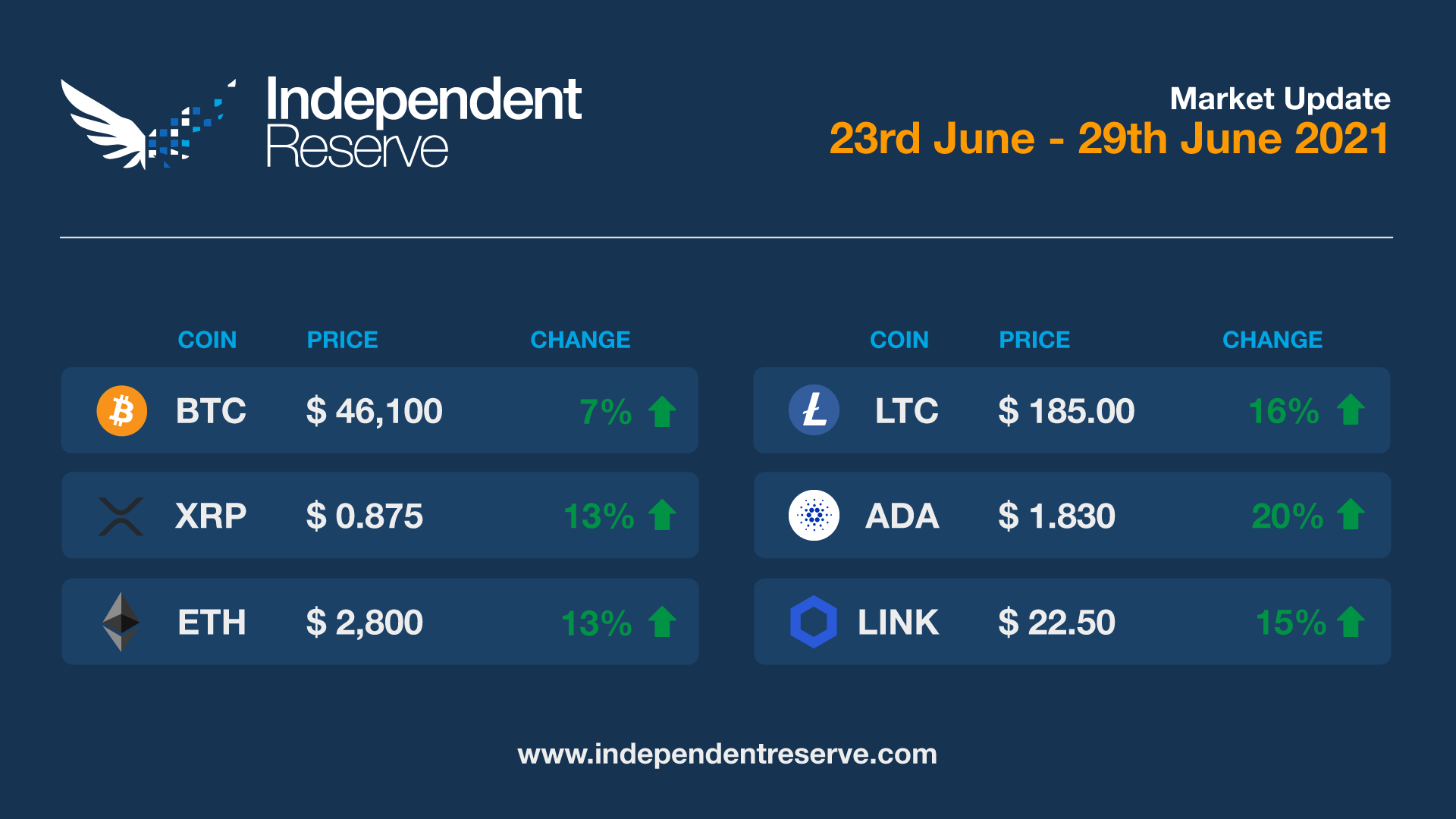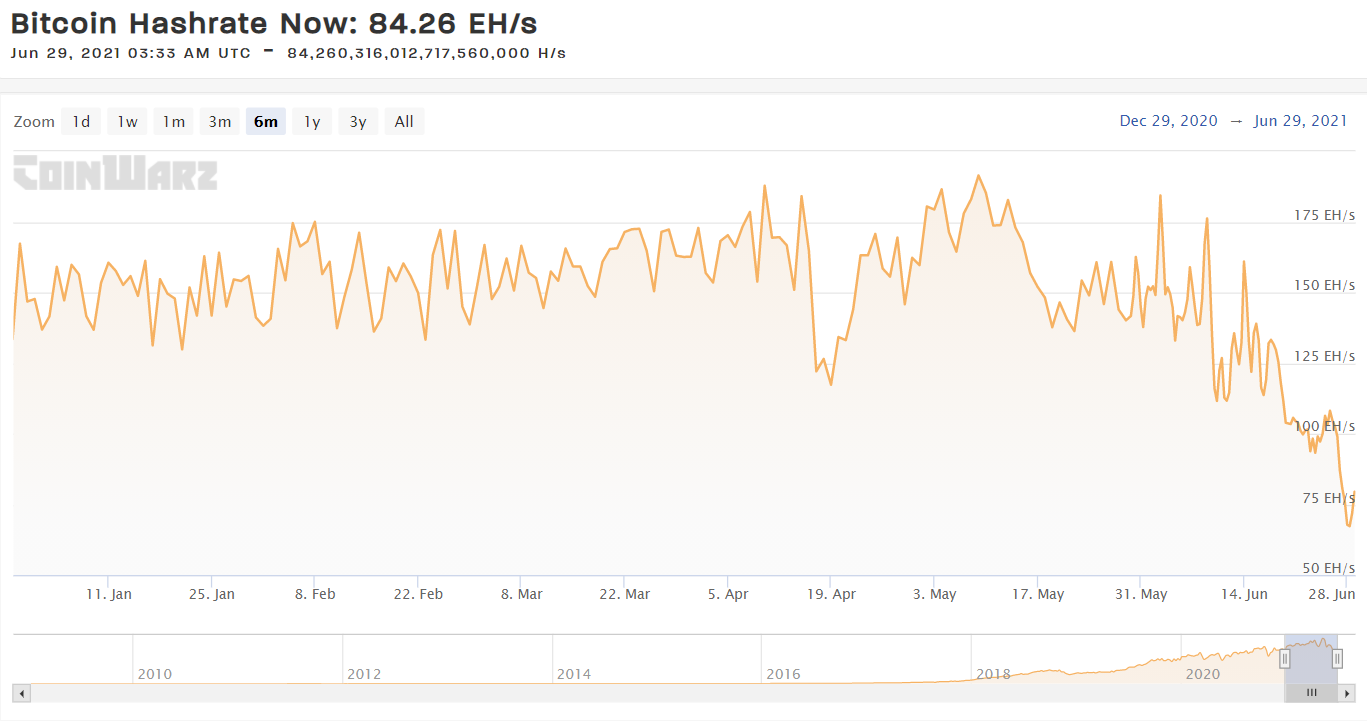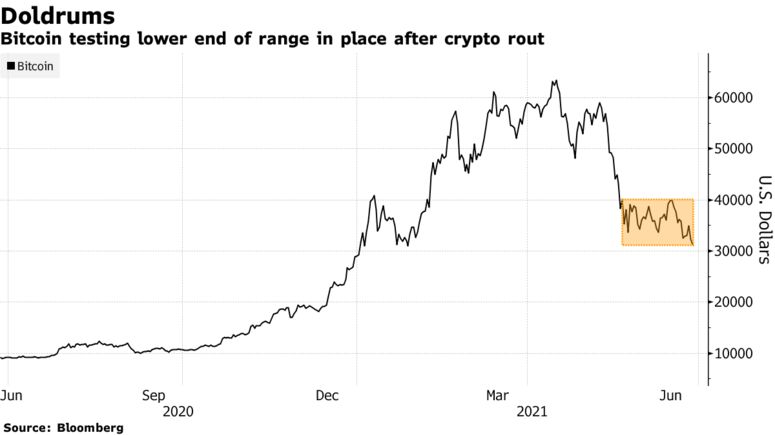In Markets
It’s too early to say if things are turning around but thanks to an overnight surge there are definitely some green shoots with Bitcoin up 7.9% this week to trade around A$45,300. It’s at the same price it was a month ago and it seems to have found a floor above the US$30K level (A$39.64K). Ethereum meanwhile gained 8.6%, Ripple was up 3.8%, Litecoin (7.8%), Bitcoin Cash (7%) Chainlink (6.3%), Stellar (8.9%), EOS (6.9%), Aave (4.3%) and Synthetix (4.8%). Polkadot lost 1%. The overall crypto market cap is around A$1.85 trillion.

In Headlines
Drawn and quartered
Earlier this week it looked as if the second quarter of 2021 would go down in history as the worst quarter since the start of the 2018 bear market, and the second worst since the beginning of 2014. However, things have improved slightly since then and the current 41.4% loss to June 29 would only make it the worst quarter since the end of 2018 when BTC lost 42.5%. The hash rate has fallen off a cliff to 66.4 EH/S (down from a peak of 171 EH/S in mid-May) thanks to the China mining ban and blocks are painfully slow — with just 77 blocks on June 27 as opposed to the 144 normally. Mining difficulty is set to adjust by a record 24%.

With this being set to be the largest difficulty drop in history, and therefore the largest loss of mining power, many are understandably concerned about what this might mean for the Bitcoin network and its security. The good news is: it appears to mean nothing. The Bitcoin network continues to produce blocks (albeit slower until this difficulty adjustment) and while the hash power has reduced, as a comparison it is still many orders of magnitude stronger than even Ethereum (Ethereum’s hash power is 0.0007% that of Bitcoin’s). An event like this is a great way to showcase Bitcoin’s resilience; as Andreas M. Antonopoulos would say – tick tock new block.
So, what is mining difficulty anyway?
Designed to adjust itself every 2016 blocks, mining difficulty determines how challenging it is for miners to solve the cryptographic puzzle required to mine new blocks. The amount of hash power utilised on the network determines the length of time it takes to create blocks, a process that is supposed to take 10 minutes according to the network’s rules. If production is faster than 10 minutes, the network will increase its difficulty. Inversely, if a large number of miners go offline, the block production time will increase and the network will ease its difficulty.
Bank on it
Mexican billionaire Ricardo Salinas Pliego – the country’s third richest man – had revealed he is working towards his bank Banco Azteca accepting Bitcoin. Banco Azteca has annual revenues of US$2.54 billion (A$3.36B) and operates in Mexico, Panama, Guatemala, Honduras, and Peru. Pliego invested 10% of his fortune in Bitcoin last year.
JPMorgan notes it
JPMorgan released a note to clients last week that suggested institutions are not buying the dip, as evidenced by outflows from regulated funds, and that the fair value for BTC in the medium term could range from US$23K to $35K (A$30.4K to $46.3K). The note included a chart suggesting the recent price crash was similar to “the 2017/18 cycle in some ways” but Real Vision CEO Raoul Pal countered this on Twitter with his own chart suggesting the current price action is more comparable to the “mid cycle correction in 2013”. A more recent note from different JPMorgan analysts is more optimistic and suggests that while the crypto market isn’t yet healthy “it does also appear to be beginning the process of healing.”

Big buying opportunity
MicroStrategy CEO Michael Saylor believes China’s crackdown on mining and trading is a “trillion dollar mistake“. But he points out the subsequent halving in the Bitcoin price is a huge opportunity. “A lot of Chinese had to sell bitcoin under forced liquidations and with a timeframe because they had to get out of the country and all their loans got pulled—so that’s been a big opportunity for Western investors,” he said. MicroStrategy recently bought another 13,000 coins on sale. “Companies like mine bought Bitcoin in the US$30,000 range (A$39.6K), we’d have paid double or even triple if it hadn’t been for the China exodus, so we got a benefit from that,” he said.
Bits and pieces
More than 40% of PlanB’s Twitter followers no longer believe that Bitcoin will top US$100K (A$132K) this year, which would invalidate his stock to flow model. That’s up from just 16% when he conducted a similar poll in March. El Salvador President Nayib Bukele announced late last week the government would airdrop $30 (A$39.60) to every adult citizen who downloads the official Bitcoin wallet to kickstart adoption. The country’s Bitcoin law, making it legal tender, goes into effect on September 7. March 25 saw the largest Net Realised Profit/Loss of all time, when newbies realised $3.45B (A$4.56B) of net realised losses in a single day. “Even Black Thursday wasn’t so bloody” tweeted the Chief Investment Officer at Moskovski Capital. Eric Rosengren, president of the Federal Reserve Bank of Boston has listed Tether among the “financial stability challenges” the U.S. central bank is watching. Celisus CEO Alex Mashinsky remains optimistic that Bitcoin will hit $160,000 (A$211K) this year. In March he successfully predicted the current correction. “When you go too high, too fast, you are bound for a correction,” he said of the price slide.
Upgrading Ethereum
Ethereum’s new London upgrade has hit the Ropsten testnet, meaning that fee burning and possibly even deflation of the supply is just around the corner when EIP-1559 goes live in July. Influencer Lark Davis points out that Ethereum now settles more value in a quarter than PayPal does in a year. Around 100,000 ETH was deposited into the Eth2 contract in a single day last week, bringing the total to 5.93 million ETH now staked which is more than 5% of the total supply. CNBC’s Jim Cramer has been loading up on Ethereum recently. “I like Ethereum because people actually use it much more to be able to buy things,” he said.
Buy signal spotted
The Puell Multiple is flashing a buy signal for Bitcoin for only the fifth time in its history. It is calculated by dividing the daily issuance value of BTC by the 365-day moving average. Creator David Puell noted it was, “Looking good, yes, but remember that Puell Multiple reacts to hash rate movements too, and hash rate follows price, not the other way around.” Asset managers have turned bullish with the number of long futures contracts up 35% this week to the highest point since the end of 2020. Overnight a new filing emerged showing that Morgan Stanley now owns 28,298 shares of the Grayscale Bitcoin Trust as of April 30.
Largest Crypto Fund
Silicon Valley venture firm Andreessen Horowitz (also known as a16z) is launching a new crypto-focused fund dedicated to expanding the size and marketability of blockchain projects. Having more than US$2.2 billion to invest, the firm states that this is “the largest crypto fund ever raised to date”. Officially announced on Thursday, Crypto Fund III, co-led by Chris Dixon and Katie Haun aims to “invest in all stages, from early seed-stage projects to fully developed later-stage networks”. The firms delve into crypto has been broad, ranging from DeFi to Bitcoin applications to Web 3.0. Their blockchain portfolio includes some of the most prominent names in the industry, which includes Coinbase, Facebook’s Diem, Compound, and Maker, among several others.
Until next week, happy trading!


